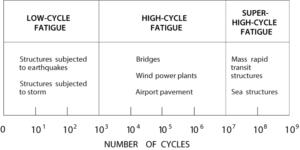For many structural engineers, the subject of fatigue analysis has been limited to a few simplified evaluations based on the American Institute of Steel Construction (AISC) Steel Construction Manual that says less than 2,000,000 cycles implies no problem. For concrete structures, the presumption of any fatigue loss was never even a design consideration in typical coursework or practice. Therefore, professional structural engineers in the U.S. have never actually been trained in understanding the effects of fatigue and fracture mechanics, except Northridge Earthquake’s impact on welded steel moment frame connections.
The industrial age (1920 to 1960) saw a proliferation of new buildings, bridges, and infrastructure elements built under this methodology. As the profession continues to evolve into more esoteric, analytical, and focused areas, structural engineers realize that the issue of fatigue is more than just a textbook discussion and has very real implications on the long term considerations of structures. Structures are now passing 50 years. Some have well over 100 years of service life and are beginning to show severe signs of long-term wear and tear. This is particularly true of bridges of both steel and concrete where cracking, corrosion, and fractures are limiting the extended life of these vital arteries of our economy. Why is fatigue analysis important? Here are the fundamental reasons:
- Fatigue loading leads to fractures, cracking, and eventual collapse/failure because the structure will likely fail before it reaches its yield point. Even though the structure is elastic, it still poses a life-safety threat to occupants.
- Designing for strength, ductility, dynamic response, strain compatibility, and serviceability are fundamental but have no correlation to fatigue analysis. A structure can be compliant with all of the basic tenets of structural design and still fail in fatigue. Increasing the strength (i.e. yield strength/stiffness) does not necessarily contribute to better fatigue strength.
- Fatigue failure is the result of a high number of cycles with low to moderate stress over an extended period that eventually fractures the material and causes failure. These fractures will grow and ultimately undermine the structural strength of the member and the system.
The purpose of this brief introduction to fatigue analysis is to raise awareness. It is an important part of design for the long-term performance of concrete and steel structures.
Fatigue in Concrete Structures
Concrete fatigue is due to long term low amplitude force or stress, with many cycles occurring over the life of the structure, that leads to concrete fracture. This can happen in tension, shear, and compression failure zones. Concrete fatigue is addressed by one internationally accepted code: FIB Model Code 2010, part of Eurocode 2. The basic tenets of fatigue analysis and analytical models are contained in this document. The principle of fatigue analysis relies on an empirical design model:
- A stress-cycle (S-N) curve is developed based on cyclic fatigue load test data. This is the Envelope of Failure for the structure.
- The analysis is based on summing the various fatigue loads to determine if the final structure “fits” within this Envelope.
- The basic rule is the Palmer-Migren Summation or the Minor’s Rule method of fatigue analysis.
With concrete material, the fatigue cracking is not physically visible; because concrete experiences a strain softening at high cycles, the crack propagation will continue un-noticed.
Think about all of the concrete structures that are impacted by this type of loading:
- Bridges
- Concrete Buildings (mostly commercial structures)
- Hospitals
- Pavements
- Theaters
- Stadiums
Fatigue in Steel Structures
Steel structures experience strain hardening with high cycle fatigue, so failure patterns are different. With steel, the critical points are stress concentrations, welds, and bolted connections.
Steel structures with fracture failure mechanics that are impacted by fatigue loading include:
a) Steel Bridges
b) Reinforcement in Concrete Structures
c) Steel Moment Frame Buildings
Wind Tower Projects
The author’s experience with fatigue analysis comes from 20 years of practice in the wind energy industry. In this field, the topic of fatigue check surpasses the normal strength design issues and usually governs on wind tower projects. The reasons are obvious; the wind tower supports a functioning machine (wind turbine) that will generate 20 million cycles of loading over a 25-year service life. It stands to reason that when structural engineers think of bridges, which are expected to last for 75+ years (sometimes over 100 years), fatigue analysis should be considered in their design methodology.The same principle applies to buildings and other structures.
Long Term Considerations
The U.S. should seriously look at our design codes to incorporate this relevant topic into our design process. Currently, there is minimal guidance. Bridge codes (AASHTO) do have some requirements for fatigue analysis, but these are not as sophisticated as European codes. As for buildings, there are no requirements for these considerations. As we see more of our structures surpass 80 to 100-year service lives, we will recognize the importance of fatigue analysis as part and parcel of structural design.▪




